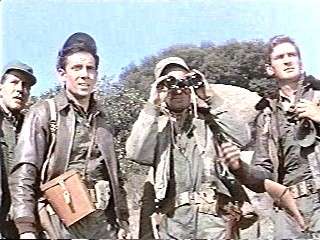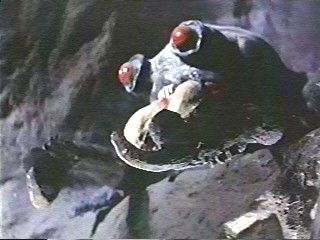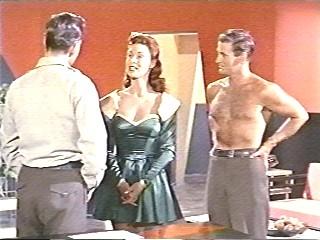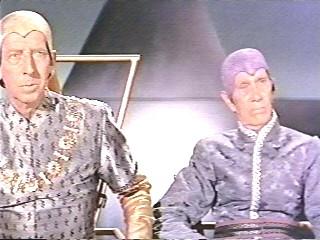
|
|
|
|
|
|
|
|
|
|
|
|
|
(1956) Director: Edward Bernds
Throughout Hollywood history, there have been a few
prominent movie companies that each have been called, "The little movie
studio that could," like R.K.O. Though when looking back on the Allied
Artists studio, One of the more interesting releases to come out of Allied Artists was World Without End, for a number of different reasons. The first that it was a science-fiction film, when just about all the other films being released by the company were horror films, crime dramas, teen exploitation, westerns, and films with titles that eloquently summed up their plots (I Passed For White, Unwed Mother, etc.) Another was that it was given deluxe treatment not common for science fiction films from any studio. Since our parents and grandparents years ago were too stupid to appreciate the science fiction genre, there was then only a small audience immediately available for a science fiction movie. This of course usually meant that these movies had to be made quite cheaply, with cost-saving film techniques like black and white photography being used. But not only was World Without End filmed in Technicolor, but it was also photographed in the pricey CinemaScope widescreen process; in fact, the movie actually beat Forbidden Planet by a matter of months as being the first sci-fi movie to be photographed this way. The third interesting thing about the movie is that unlike the attitude most sci-fi movies had for the time, typically gee-whiz fantastic and to hell with science and common sense, the end results here show that at least some effort had been made to give the movie a plausible and even intelligent edge. That's not to say that the movie really did its homework
like Destination Moon did six years earlier - far
from it. Even viewers watching the movie today who never had a
particular interest in science will be laughing out loud from spotting When they all regain consciousness, they discover they have miraculously crash-landed intact on the snowy mountains of some planet. They know it can't be Mars - the pressure outside and the atmosphere itself are both in acceptable limits to humans. At the same time, they figure out they can't be on Earth, since they are not picking up any radio signals, and the background radiation count is a few levels above what it is on Earth. Of course, all this "subtle" information instantly lets us know that not only is there's going to be a "big twist" later in the movie, but also exactly what this big twist is going to be. But try to tell these guys that; they are remarkably slow in figuring out that they weren't on the right track, even after they pack their bags and make the slow trek down the mountains. For one thing, they don't mention how the grass and bushes they keep passing look remarkably similar to flora found on Earth. "Gross stupidity" must be the answer, since it also explains why when they enter a cave and see an incredibly big spider web, they don't know what it is even when they walk up to it. Okay, they are obviously accustomed to smaller spiders and not mutant giants (which of course drop down and attack them mere seconds later)... but they apparently didn't have the brainpower to even think, "This looks like a giant spider web!" Even that night, when they are suddenly attacked by
club-wielding cavemen with mutated faces, these four dimwits still don't
get it; from their reaction after they manage to fight off the cavemen,
it wasn't enough that the mutant-faced cavemen otherwise resembled
modern man perfectly. It's only Yes, among many of World Without End's delights are women straight out of one of those Amazon-themed movies that were particularly popular in this decade! "It's hard to discard centuries of tradition," one character comments during all this interplay, which explains why the women of this particular century lust after men who have the courage to keep them under control and will make various sexist comments towards them. This provides a good deal of hilarity, though it's not the only provider of unintentional laughs. Although the movie had the budget for color and widescreen, it apparently didn't have much left over for some important things the movie still needed - like special effects. There aren't actually that many special effect sequences, but when one does occur, it's usually a delight to see, for all the wrong reasons. The planet Mars is very obviously a ball covered with red-colored paper mache, and the XRM rocket orbiting it does the familiar superimposed-shuffle. Funnier is when the XRM crashes into the mountains, with the whole thing coming across as a child shooting a movie using props he constructed and manipulated all by himself. Then that spider attack sequence... well, I'm totally convinced it was inspired by the octopus-wrestling sequence in the previous year's Bride Of The Monster. And while I'm no rocket scientist, I could with complete confidence recognize unlikely things like astronauts decked out in WW II flying gear (and no spacesuits around even for backup), or carrying guns and ammunition with them on their space flight. There is enough unintentional humor to be found in World
Without End to legitimately call it a so-bad-it's-good movie.
Yet it's not without genuine merit, having Even in the more inaccurate parts of the movie, you can usually find a few small touches of intelligence hanging on the edges. It was nice to see the crew of a spacecraft in a movie, for once, know that they only have to turn on their spacecraft's rockets for just several seconds to get them moving along in the atmosphere-free space. The interior of the spacecraft, while far from looking high-tech, still looks a lot more plausible that what's usually seen in these kind of movies of the era. There are also a number of small nuggets thrown in passing, as when the underground society during a meeting shows to be largely ignorant of basic Latin terminology; not surprising, after this society has lived in a restricted environment for so long. Despite all these and additional interesting things, it can't be denied director Bernds' script is more silly than smart. But you certainly can't say it's ever boring, moving from one plot turn to another quite speedily. His direction adds some extra flavor to things as well. The world outside the shelter has an appropriate feeling of desolation and emptiness, without ever having to showing things like ruins of cities. And while the cavemen look silly with those mutated faces, they all the same come across as menacing, thanks to carefully choreographed (and at times surprisingly violent) battle sequences. So we also have action to go along with (among other things) cheesy effects, man-hungry women, laughable dialogue and actions, space travel, time warps, murderous mutants, and occasional intelligence. It's as close to a perfect movie as we'll ever get. UPDATE: Mike Muller sent along this trivia: "In Tom Weaver's "Interviews With B Science Fiction
and Horror Movie
Check for availability on Amazon (VHS) See also: America 3000, Survivor, Warlords 3000 |
 one is most likely
to say that A.A. was instead, "The little studio that couldn't."
Actually, after taking the time to study the studio all the way from
when poverty-row studio Monogram formed it in 1945, I think it's more
accurate to call A.A. "The little studio that wouldn't."
Although the product they made was often with higher budgets than the
movies coming from other poverty-row studios, there is still no
mistaking their product as being aimed for the B-movie market. The same
goes with most of the movies they handled strictly as a distributor.
True, there were definitely a few occasions where they made and/or
distributed bigger-budgeted movies. What is strange is that most of the
time they did so - such examples include El Cid, Cabaret,
The Man Who Would Be King, and The Betsy -
they were met with significant success at the box office. Yet these
instances of success didn't seem to encourage them to take any more
risks than they were already making at the time. Though on the other
hand, one does have to take in account that Allied Artists seems not to
have been run very well; not only did the Mirisch brothers have to
leave the company to make wildly successful movies like The
Magnificent Seven, Allied Artists often teetered on the brink
of bankruptcy, finally collapsing in the late '70s. Subsequently, their
remains were absorbed by Lorimar (which was absorbed by Warner Brothers
several years later.)
one is most likely
to say that A.A. was instead, "The little studio that couldn't."
Actually, after taking the time to study the studio all the way from
when poverty-row studio Monogram formed it in 1945, I think it's more
accurate to call A.A. "The little studio that wouldn't."
Although the product they made was often with higher budgets than the
movies coming from other poverty-row studios, there is still no
mistaking their product as being aimed for the B-movie market. The same
goes with most of the movies they handled strictly as a distributor.
True, there were definitely a few occasions where they made and/or
distributed bigger-budgeted movies. What is strange is that most of the
time they did so - such examples include El Cid, Cabaret,
The Man Who Would Be King, and The Betsy -
they were met with significant success at the box office. Yet these
instances of success didn't seem to encourage them to take any more
risks than they were already making at the time. Though on the other
hand, one does have to take in account that Allied Artists seems not to
have been run very well; not only did the Mirisch brothers have to
leave the company to make wildly successful movies like The
Magnificent Seven, Allied Artists often teetered on the brink
of bankruptcy, finally collapsing in the late '70s. Subsequently, their
remains were absorbed by Lorimar (which was absorbed by Warner Brothers
several years later.) a number of
scientific goofs, thanks to what they have picked up by more accurate
science fiction films and TV shows over the years. They will also be
laughing at things ranging from dated special effects to dated
attitudes. The core of World Without End is still that of
a more plausible premise, but boy, does it come across as dumb much of
the time. Yet I found I could enjoy the movie on both levels,
appreciating the occasional smart touches while finding a lot of humor
in its mistakes and occasional awesome naivety. You could call it a
smorgasbord of a movie, including how the plot keeps turning in a new
direction for its first part. It opens in space in that
far-in-the-future date of 1957, where the XRM rocket has just become
the first manned spacecraft to circle Mars. Its four man crew is headed
by Dr. Eldon Galbraithe (Leigh, Gunfight At The O.K. Corral)
and John Borden (Marlowe, Earth Vs. The Flying Saucers),
with the rest of the crew consisting of radio operator Herbert Ellis
(Taylor, The Time Machine), and navigator Henry Jaffe
(Christopher Dark). Though none of them get much chance to indulge in
any of their duties before their ship suddenly gets caught in one of
those typical mysterious rara avis found in space movies like
this, this particular one accelerating their ship at such a high speed
that they all black out.
a number of
scientific goofs, thanks to what they have picked up by more accurate
science fiction films and TV shows over the years. They will also be
laughing at things ranging from dated special effects to dated
attitudes. The core of World Without End is still that of
a more plausible premise, but boy, does it come across as dumb much of
the time. Yet I found I could enjoy the movie on both levels,
appreciating the occasional smart touches while finding a lot of humor
in its mistakes and occasional awesome naivety. You could call it a
smorgasbord of a movie, including how the plot keeps turning in a new
direction for its first part. It opens in space in that
far-in-the-future date of 1957, where the XRM rocket has just become
the first manned spacecraft to circle Mars. Its four man crew is headed
by Dr. Eldon Galbraithe (Leigh, Gunfight At The O.K. Corral)
and John Borden (Marlowe, Earth Vs. The Flying Saucers),
with the rest of the crew consisting of radio operator Herbert Ellis
(Taylor, The Time Machine), and navigator Henry Jaffe
(Christopher Dark). Though none of them get much chance to indulge in
any of their duties before their ship suddenly gets caught in one of
those typical mysterious rara avis found in space movies like
this, this particular one accelerating their ship at such a high speed
that they all black out. when the four find a
long-abandoned graveyard that they finally get a clue where they are,
thanks to the tombstones still looking perfectly clear after several
hundred years exposed to the elements. (Well, maybe they invented a
type in the future stronger than what we presently use.) However,
though they correctly theorize some big disaster must have happened in
2188 because of the many tombstones with that date, they still
can't guess what it was. Fortunately for them (as well as the
exasperated audience), when fleeing into a cave after another run-in
with those ugly cavemen, they discover a society made up of the
descendants of the original survivors of the holocaust, all living in a
complex underground city of sorts. The society welcomes the four men,
giving them plenty of hospitality, though it turns out the women of
this society are the ones who want to give the most hospitality to
these absolute studs. "My! You sure are more muscular than our men!"
one woman exclaims at one point, simultaneously circling around to
thoroughly inspect the man she just complimented. "Are the girls in
your world as beautiful as ours?" another woman insists on knowing.
when the four find a
long-abandoned graveyard that they finally get a clue where they are,
thanks to the tombstones still looking perfectly clear after several
hundred years exposed to the elements. (Well, maybe they invented a
type in the future stronger than what we presently use.) However,
though they correctly theorize some big disaster must have happened in
2188 because of the many tombstones with that date, they still
can't guess what it was. Fortunately for them (as well as the
exasperated audience), when fleeing into a cave after another run-in
with those ugly cavemen, they discover a society made up of the
descendants of the original survivors of the holocaust, all living in a
complex underground city of sorts. The society welcomes the four men,
giving them plenty of hospitality, though it turns out the women of
this society are the ones who want to give the most hospitality to
these absolute studs. "My! You sure are more muscular than our men!"
one woman exclaims at one point, simultaneously circling around to
thoroughly inspect the man she just complimented. "Are the girls in
your world as beautiful as ours?" another woman insists on knowing. moments that are
thoughtful, even intelligent at times. There's not a terrible amount of
difference between one of the astronauts from the other, but at least
the uniformity includes amiable personalities. Though they do make
sexist comments towards the women, they usually do it in a kidding
manner. They do enjoy the pampering, but they don't let it go to their
heads. John takes the time to slow down during one romantic clinch to
tell the woman attracted to him that they've only known each other for
a short while and he's still a stranger; Eldon enjoys the pampering he
gets, but never lets it out of his mind that he's still over 50 and a
grandfather. Henry, devastated over the fact that he'll never see his
wife and kids again, doesn't even to get into a relationship in the
colony. His grieving is shown too briefly, but unlike many movies that
involve personal loss, it's at least shown, adding some poignancy. The
four never abuse their privilege in being at the colony; in fact, when
they soon discover that the colony is dangerously close to extinction,
they immediately offer their services - and finding a curious
reluctance. The subsequent scenes includes some interesting looks into
the psyche of the colonists, not only why they feel the way they do,
but how they came to feel this way. There is also some interesting talk
about how humans were supposed to live, and that in a way even the
society that the astronauts came from had changed the basic human
spirit.
moments that are
thoughtful, even intelligent at times. There's not a terrible amount of
difference between one of the astronauts from the other, but at least
the uniformity includes amiable personalities. Though they do make
sexist comments towards the women, they usually do it in a kidding
manner. They do enjoy the pampering, but they don't let it go to their
heads. John takes the time to slow down during one romantic clinch to
tell the woman attracted to him that they've only known each other for
a short while and he's still a stranger; Eldon enjoys the pampering he
gets, but never lets it out of his mind that he's still over 50 and a
grandfather. Henry, devastated over the fact that he'll never see his
wife and kids again, doesn't even to get into a relationship in the
colony. His grieving is shown too briefly, but unlike many movies that
involve personal loss, it's at least shown, adding some poignancy. The
four never abuse their privilege in being at the colony; in fact, when
they soon discover that the colony is dangerously close to extinction,
they immediately offer their services - and finding a curious
reluctance. The subsequent scenes includes some interesting looks into
the psyche of the colonists, not only why they feel the way they do,
but how they came to feel this way. There is also some interesting talk
about how humans were supposed to live, and that in a way even the
society that the astronauts came from had changed the basic human
spirit.